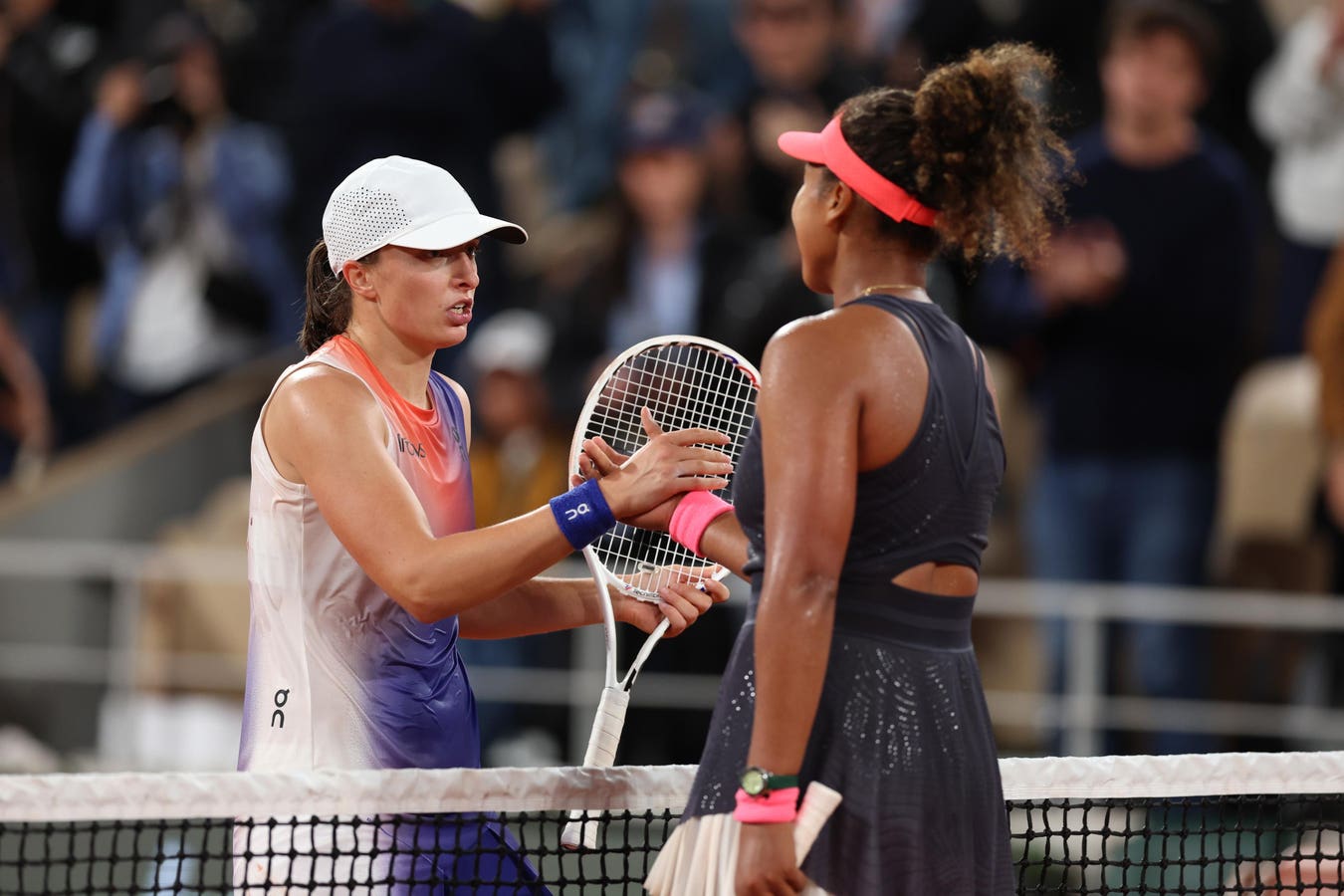PARIS, FRANCE – MAY 29: Iga Swiatek of Poland (L) shakes hands with Naomi Osaka of Japan after her … More
After beating Tommy Paul in 94 minutes during the Tuesday night session at the French Open, Carlos Alcaraz apologized to the crowd. “I have to say, I know you wanted to watch more tennis. I have to say sorry about it. I had to do my work but, once again, it’s great to play in front of all of you,” the defending champion said as he made it through to the semifinals to meet Lorenzo Musetti.
On Wednesday, the two women’s quarterfinal matches – which were won in straight sets by Iga Swiatek and Aryna Sablenka – both lasted longer than Alcaraz’s demolition job on the American. On Sunday, Swiatek played former Wimbledon champion Elena Rybakina in a two-and-a-half-hour epic, a match that started in a virtually empty Phillippe-Chatrier Court. Two Slam winners in a quiet amphitheater felt wrong. They didn’t need to play an incredible encounter to justify the slot.
World No.1 Sabalenka has spoken directly on how women’s tennis should have an equal billing with the men’s side. “There were a lot of great battles that would be cool to see as a night session. More people in the stands watching these incredible battles. Just to show our self to more people. I definitely agree that we deserve to be put on a bigger stage, better timing, more people watching,” Sabalenka said after her victory over Qinwen Zheng.
The storyline was strong. Sabalenka lost to her Chinese rival for the first time at the Italian Open. This was her fight to get her major rights back. Clearly, the narrative wasn’t strong enough to reach out to the peak hours.
Four-time French Open champion Swiatek, who will face Sabalenka in a blockbuster semifinal on Thursday, agreed in more low-key style. Ons Jabeur pushed back more forcefully. “Of course, they watch men more because you show men more. Everything goes together,” said the two-time Wimbledon runner-up.
The debate about the evening sessions being the domain of the men was validated to some degree by tournament director Amelie Mauresmo. “Since men’s tennis is played at the best-of-five sets, three sets will be played at a minimum. It’s complicated for us to do otherwise.”
“It’s complicated” is a diplomatic way of suggesting that the fear of a woman’s match to deliver, to not go deep into the night will always dictate the schedule.
In a one-on-one contest, the men will always prevail right here, right now in the French Open. Novak Djokovic’s 41-shot rally to fend off Alexander Zverev just before midnight made good visuals and got Mauresmo off the hook to some extent. The tournament needed a near midnight finish after Sinner blasted Andrey Rublev away and Alcaraz’s quick kill of Paul.
One look at last year’s epic second-round clash between Swiatek and Naomi Osaka in Paris is to see what is possible. “Swiatek v Osaka is a brilliant watch. ”[The] WTA need to do more to capitalise on these match ups!,” said Mauresmo’s former client Andy Murray, but the match was played in front of a half-empty court.
Dimple Thakkar is the CEO of Fifteen Thirty Forty, a next-gen tennis brand. “Swiatek versus is not a risk. That’s a blockbuster. Fans don’t want longer matches. They want meaningful ones. It’s about fear—of evolution, of disruption, of rethinking power dynamics. Sidelining women’s tennis in prime time isn’t just outdated. It’s leaving relevance—and revenue—on the court,” Thakkar told me.
Only four women’s matches have taken center stage for the closing hours of play since night sessions were introduced at Roland Garros in 2021. The Australian Open and U.S. Open have two matches that can go into the early hours of the morning. Technically, this offers value for money but sessions that end at 3 am naturally lose fans because of overtime and also impact player welfare.
Spectators attend the night session of the men’s singles match between Italy’s Jannik Sinner and … More
Sabalenka herself wasn’t best pleased when she was made to start her third-round match against Ekaterina Alexandrova in the early hours of the morning at Flushing Meadows in August. “I was like ‘no way.. I’m gonna start at midnight’. And that’s actually what happened. That was tricky,” said the Belarusian at the time. This was after Novak Djokovic get knocked out by Alexei Popyrin in front of a 24,000-capacity crowd on Arthur Ashe.
“WNBA viewership is up 300%. Women’s NCAA games are shattering TV records. The market has spoken—loudly. And yet, somehow, women’s tennis still gets benched at night,” Thakkar told me. The gentlemen’s club still hold the cards.










